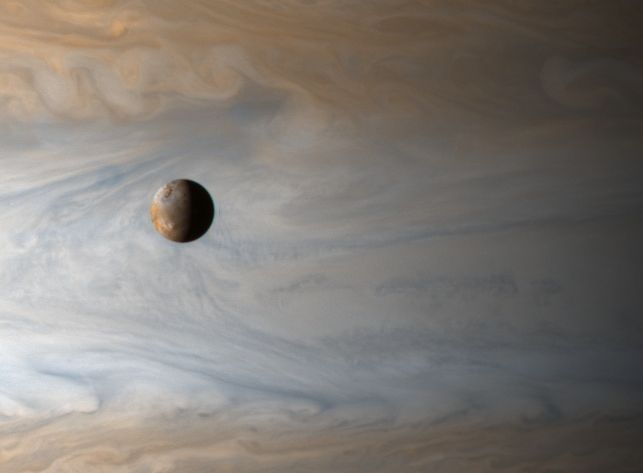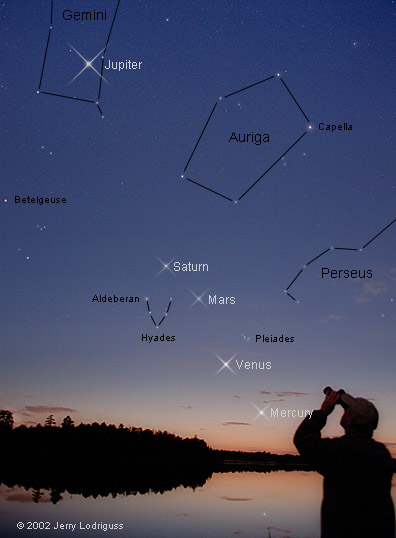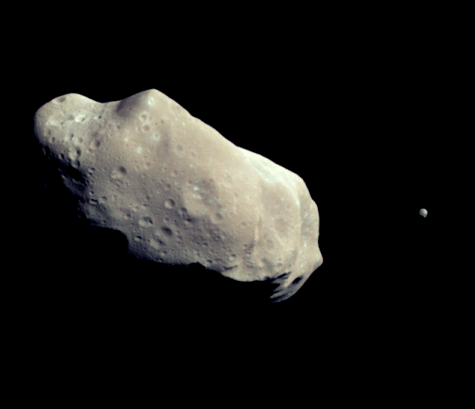Earth, Moons, Planets & Asteroids
Most pics courtesy of NASA
Smog Over New York


Explanation: What is not pretty about the above picture? In a word: smog. In 2000 October the orbiting Space Shuttle Discovery photographed upstate New York just at sunset. Visible is golden sunlight reflecting from two of the Great Lakes (Erie and Ontario), and several of the Finger Lakes. Between the clouds at the top and ground at the bottom, however, is a trapped layer of smog. Smog is mostly ozone but may contain small amounts of volatile organic compounds. As opposed to "good smog" in the upper atmosphere, "bad smog" near the ground is created mostly by humans. In the upper atmosphere, ozone reflects back harmful ultraviolet radiation, but when it occurs near the ground, it can be inhaled. Smog continues to be studied with an eye for how it develops and how it affects human health.

Explanation: Also known as the Moon's "ashen glow" or "the old Moon in the new Moon's arms", Earthshine is Earthlight reflected from the Moon's night side. This dramatic image of Earthshine and a young crescent Moon was taken by astrophotographer and APOD translator Laurent Laveder from the remote Pic du Midi Observatory on planet Earth. But the view from the Moon would have been stunning too. When the Moon appears in Earth's sky as a slender crescent, a dazzlingly bright, nearly full Earth would be seen from the lunar surface. The Earth's brightness, due to reflected sunlight, is strongly influenced by cloud cover. Recent studies of Earthshine indicate that it is more pronounced during April and May. A description of Earthshine, in terms of sunlight reflected by Earth's oceans in turn illuminating the Moon's dark surface, was written 500 years ago by Leonardo da Vinci.

Explanation: How big is the Jovian moon Io? The most volcanic body in the Solar System, Io (usually pronounced "EYE-oh") is 3,600 kilometers in diameter, about the size of planet Earth's single large natural satellite. Gliding past Jupiter at the turn of the millennium, the Cassini spacecraft captured this awe inspiring view of active Io with the largest gas giant as a backdrop, offering a stunning demonstration of the ruling planet's relative size. Although in the picture Io appears to be located just in front of the swirling Jovian clouds, Io hurtles around its orbit once every 42 hours at a distance of 420,000 kilometers or so from the center of Jupiter. That puts it nearly 350,000 kilometers above Jupiter's cloud tops, roughly equivalent to the distance between Earth and Moon. The Cassini spacecraft itself was about 10 million kilometers from Jupiter when recording the image data.

Explanation: A great grouping of planets is now visible to the west just after sunset. Over the next two weeks, Mercury, Venus, Earth, Mars, Jupiter, and Saturn -- the innermost six planets of our Solar System -- can be seen in a single knowing glance. The image on the left captured them all in one frame. Connecting the planetary dots delineates the edge-on ecliptic, the plane in which the planets orbit the Sun. The shot was taken on April 23, 2002 near Chatsworth, New Jersey, USA, and even includes scattered light from the Sun and the Moon. Besides the planets, the Pleiades and Hyades open clusters of stars are visible.

Explanation: Venus, named for the Roman goddess of love, and Mars, the war god's namesake, approach each other by moonlight in this lovely sky view recorded on May 14, 2002 from Dunkirk, Maryland, USA. The four second time exposure made in twilight with a digital camera also records earthshine illuminating the otherwise dark surface of the young crescent Moon. Venus shines as the third brightest object in Earth's sky, after the Sun and the Moon itself, and has been appearing as the brilliant evening star in the pantheon of planets arrayed in the west during April and May. Here, Venus' light is so intense that it produces a noticeable spike in the sensitive camera's image. Much fainter Mars is lower in the picture, caught between tree limbs swaying in a gentle evening breeze. By early June, Mars will be harder to spot as it wanders toward the horizon, but Venus and father Jupiter will draw closer together, presenting a spectacular pair of bright planets in the west.

Explanation: The surface of Venus is perpetually covered by a veil of thick clouds and remains hidden from even the powerful telescopic eyes of earth-bound astronomers. But in the early 1990s, using imaging radar, the Venus orbiting Magellan spacecraft was able to lift the veil from the face of Venus and produced spectacular high resolution images of the planet's surface. Colors used in this computer generated picture of Magellan radar data are based on color images from the surface of Venus transmitted by the Soviet Venera 13 and 14 landers. The bright area running roughly across the middle represents the largest highland region of Venus known as Aphrodite Terra.

Explanation: This asteroid has a moon! The robot spacecraft Galileo currently (June 2002) exploring the Jovian system, encountered and photographed two asteroids during its long journey to Jupiter. The second asteroid it photographed, Ida, was discovered to have a moon which appears as a small dot to the right of Ida in this picture. The tiny moon, named Dactyl, is about one mile across, while the potato shaped Ida measures about 36 miles long and 14 miles wide. Dactyl is the first moon of an asteroid ever discovered. The names Ida and Dactyl are based on characters in Greek mythology. Other asteroids are now known to have moons.

Explanation: Rocks from space hit Earth every day. The larger the rock, though, the less often Earth is struck. Many kilograms of space dust pitter to Earth daily. Larger bits appear initially as a bright meteor. Baseball-sized rocks and ice-balls streak through our atmosphere daily, most evaporating quickly to nothing. Significant threats do exist for rocks near 100 meters in diameter, which strike the Earth roughly every 1000 years. An object this size could cause significant tidal waves were it to strike an ocean, potentially devastating even distant shores. A collision with a massive asteroid, over 1 km across, is more rare, occurring typically millions of years apart, but could have truly global consequences. Many asteroids remain undiscovered. In fact, one was discovered in 1998 as the long blue streak in the above archival image taken by the Hubble Space Telescope. Last week, the small 100-meter asteroid 2002 MN was discovered only after it whizzed by the Earth, passing well within the orbit of the Moon. 2002 MN passed closer than any asteroid since 1994 XM1. A collision with a large asteroid would not affect Earth's orbit so much as raise dust that would affect Earth's climate. One likely result is a global extinction of many species of life, possibly dwarfing the ongoing extinction occurring now.
|